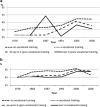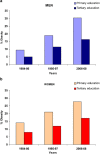Social Inequalities in Obesity Persist in the Nordic Region Despite Its Relative Affluence and Equity
- PMID: 24533235
- PMCID: PMC3920028
- DOI: 10.1007/s13679-013-0087-2
Social Inequalities in Obesity Persist in the Nordic Region Despite Its Relative Affluence and Equity
Abstract
Social inequalities in overweight and obesity (OWOB) have persisted in the affluent and reputedly egalitarian Nordic countries. In this review we examine associations between socioeconomic position (SEP) and OWOB, and secular trends in such associations. Determinants and possible causes of the relations are discussed together with opportunities to cope with OWOB as a public health problem. The findings show a persisting inverse social gradient. An interaction between SEP and gender is noted for adults in Denmark, Finland and Iceland and for children in Sweden. There are overall tendencies for increased inequality, however no consistent trend for an increased social gradient in OWOB. Reasons that increased inequality does not unequivocally mirror in a steepened social gradient in obesity may include methodological questions as well as societal efforts to counteract obesity. Multi-level efforts are needed to prevent OWOB.
Keywords: Adolescents; Adults; BMI; Children; Denmark; Education; Egalitarian; Finland; Gender; Gini coefficient; Iceland; Income; Inequality; Nordic countries; Nordic region; Norway; Obesity; Obesogenic; Occupation; Overweight; Secular trends; Social gradient; Social inequalities; Socioeconomic position; Socioeconomic status; Sweden.
Figures





References
Publication types
LinkOut - more resources
Full Text Sources
Other Literature Sources
